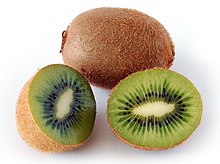Ray pen family
| Ray pen family | ||||||||||||
|---|---|---|---|---|---|---|---|---|---|---|---|---|

Kiwi blossom ( Actinidia deliciosa ) |
||||||||||||
| Systematics | ||||||||||||
|
||||||||||||
| Scientific name | ||||||||||||
| Actinidiaceae | ||||||||||||
| Gilg & Werderm. |
The ray pen family (Actinidiaceae) are a family of plants within the order of the heather-like (Ericales). The best known species is the kiwi ( Actinidia deliciosa ). They have a mainly tropical distribution, especially from Southeast Asia to the Malay Archipelago , but not in Africa.
description

Vegetative characteristics
They are woody plants: trees , bushes or lianas . They are mostly deciduous and the above-ground parts of the plant are often hairy with simple or branched trichomes . All organs often have idioblasts with raphids, clematoclethra also with crystal sand .
The alternate and spirally arranged leaves are divided into a petiole and a leaf blade. The petiole can be very short to long. The simple leaf blades are pinnate and have a smooth, usually serrated or serrated leaf margin. The stomata have no secondary cells (Ranunculaceae type), anomocytic. Stipules are usually absent or very small.
Generative characteristics
The flowers are seldom solitary, but mostly in lateral zymose , spiked or bundled inflorescences ; sometimes on the "old wood". There are usually small cover sheets.
The hermaphrodite or functionally unisexual flowers are radial symmetry , mostly fünfzählig double perianth (perianth). If the flowers are unisexual, the species can be single-sexed ( monoecious ) or dioecious ( dioecious ). The two to eight, usually five, sepals are free, usually roof-tile (imbricat) in the bud and stand in a quincunx (screw-like with a divergence of 2/5); they are mostly retained when the fruit is ripe (persistent). The three to nine, usually five, petals are free or fused at the base, roof tiles in the bud (imbricat). They are longer than the chalice. In the bud they are imbricat. Centrifugally, (10 to) 20 to 240 fertile stamens are formed. The stamens can be free or fused with the petals. The dust bag consists of two counters. The two-celled pollen grains have three apertures and are colporat. Three to five or many carpels are an above-permanent (syncarp), three or multi-chambered ovary overgrown. The surface of the ovary is hairy or smooth. In each ovary chamber there are ten to many anatropic, unitegmic, tenuinucellate ovules in a central angled placentation . Usually there is one stylus per carpel, which is free or can be fused (with Clematoclethra the stylus are completely fused into one) and sometimes also remain when the fruit ripens (hence the name ray pen, Actinidia from the Greek word aktis for rays).

Mostly fleshy berries , sometimes more or less loculicidal, leathery capsule fruits are formed. The relatively small seeds usually have large, straight or curved embryos and a lot of, mostly oily, endosperm .
The basic chromosome numbers are x = 12, 13, 14; Clematoclethra with x = 12 and Saurauia x = 13. Actinidia often has a chromosome number of n = 29, which probably developed from tetraploid ancestors with x = 14.
ingredients
In the family Actinidiaceae come iridoids before and widespread flavonols as myricetin , quercetin and kaempferol . Procyanidin and prodelphinidin indicate the existence of condensed tannins . Actinidin, a papain- like proteinase from kiwi fruit, makes contact dermatitis possible. From Actinidia polygama one was terpenoid Pseudoalkaloid isolated, which was also called Actinidine. The mucus of the Actinidia species contains acidic polysaccharides . Calcium oxalate crystals are accumulated in raphids .
use
The fruits are eaten by some species and their varieties. Varieties of a few species are used as ornamental plants .
distribution
The species of Actinidiaceae are common in tropical Asia and America, some also in temperate East Asia and northern Australia .

Systematics
The Actinidiaceae family was set up in 1925 by Ernest Friedrich Gilg & Erich Werdermann in The Natural Plant Families , Second Edition, 21, p. 36. The type genus is Actinidia Lindl. A synonym for Actinidiaceae Gilg & Werderm. is Saurauiaceae Griseb.
The Actinidiaceae family contains only three genera with a total of over 350 species:
- Saurauia Willd. : With about 300 species.
- Actinidia ( Actinidia Lindl. ): With about 55 to 60 kinds.
-
Clematoclethra (Franch.) Maxim. : With the only kind:
- Clematoclethra scandens (Franch.) Maxim.
swell
- The family of Actinidiaceae in APWebsite. (Section description and systematics)
- The Actinidiaceae family at DELTA by L. Watson & MJ Dallwitz. (Section Description and Ingredients)
- Jianqiang Li, Li Xinwei & D. Doel Soejarto: Actinidiaceae in the Flora of China , Volume 12, 2007, p. 334: Online. (Section description and systematics)
- S. Dressler, C. Bayer: Actinidiaceae . In: K. Kubitzki (Ed.): The Families and Genera of Vascular Plants. Volume 6, Springer Verlag, Cologne 2004, pp. 14-19. ISBN 3-540-06512-1
Individual evidence
- ↑ ZC He, JQ Li, Q. Cai & Q. Wang: The cytology of Actinidia, Saurauia, and Clematoclethra (Actinidiaceae) , In Botanical Journal of the Linnean Society , Vol. 147, 2005, pp. 369-374.
- ^ Actinidiaceae in the Germplasm Resources Information Network (GRIN), USDA , ARS , National Genetic Resources Program. National Germplasm Resources Laboratory, Beltsville, Maryland.